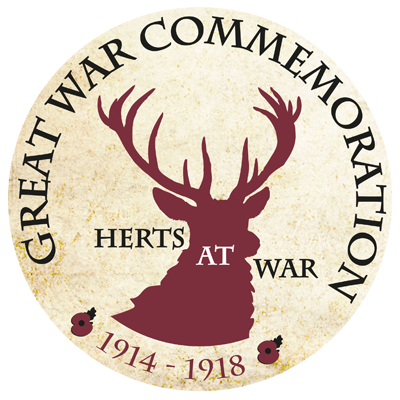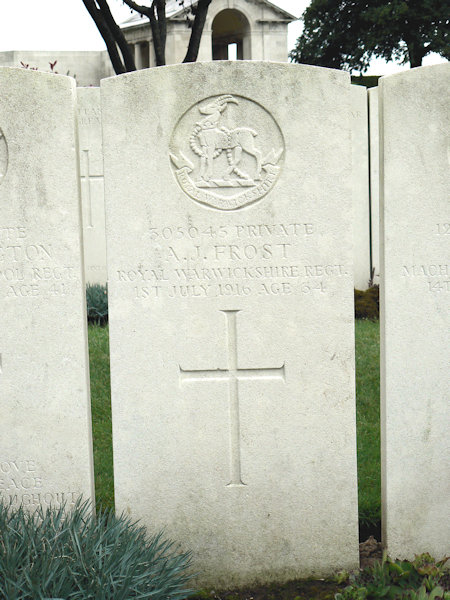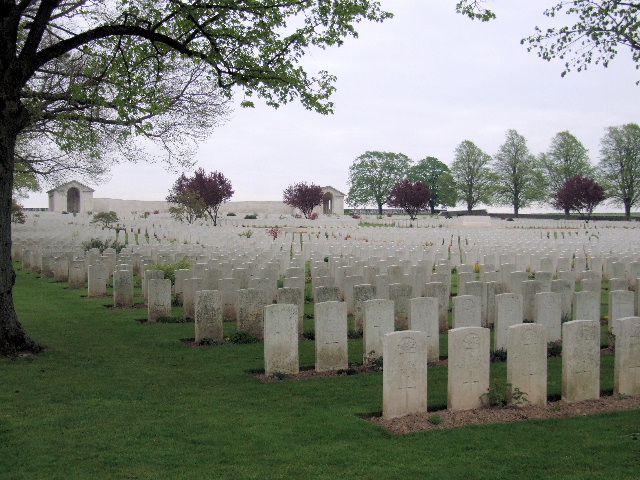Name
Arthur James Frost
01 Mar 1882
Conflict
First World War
Date of Death / Age
01/07/1916
34
Rank, Service Number & Service Details
Private
305045
Royal Warwickshire Regiment
1st/8th Bn.
Awards: Service Medals/Honour Awards
British War and Victory medals
Cemetery/Memorial: Name/Reference/Country
SERRE ROAD CEMETERY No.2
I. G. 27
France
Headstone Inscription
None
UK & Other Memorials
Northchurch Memorial,
St Mary’s Church Window, Northchurch,
Not on the Berkhamsted memorials
Pre War
Arthur James was born in Marylebone, London on 1 March 1882, the son of Harry and Mary Sophia Frost (nee Willis) and one of ten children. The family had moved to the Crooked Billet Inn at Gossom's End, Northchurch, nr Berkhamsted (now the site of a modern wine warehouse) by the time of the 1891 Census. The family were then recorded as:
- Harry Frost, age 42, Publican, born Hargrave, Suffolk
- Mary Frost, wife, age 39, born Paddington, London
- Robert Frost, Son, printer's apprentice, age 16, born Dalton, Lancs.
- Harriet Frost, Daughter, age 15, born St. James' London
- Robert Frost, Son, age 15, born St. James' London
- Ernest Frost, Son, age 13, born Dalton, Lancs.
- Beatrice Frost, Daughter, age 10, born St. George's London
- Arthur Frost, Son, age 9, born St. George's London
- Dora Frost, Daughter, age 5, born St. George's London
- Edgar Frost, Son, age 2, born Northchurch, Herts.
His parents were still living there in 1911 but Arthur was not listed with them. However, the 1911 Census records an Arthur Frost, aged 29, single man, born Marylebone London and working as an Assistant Draper. He was then living at Harold Marsh's drapery shop, 26 Powis Street, Woolwich, London.
When he enlisted, Arthur was said to be living in Berkhamsted and also gave his next of kin as living there. (N.B. Northchurch is within the registration district of Berkhamsted.)
His mother later lived at 27 Cassiobridge Road, Watford, Herts.
Wartime Service
Arthur's regimental number of 2370 (later 305045) would suggest that he enlisted at the outbreak of war in August 1914. and joined the 1/8th Battalion, Royal Warwickshire Regiment at Birmingham. The 1/8th was a Territorial Force battalion, based at Aston Cross, Birmingham in 1914.
He landed in France on 22 March 1915 and was killed on the Somme on 1 July 1916, aged 34, his unit being part of the 48th (South Midland) Division. He is buried in Serre Road Number 2 Cemetery, ref. I.G.27. France. He is also named on the War Memorials at St. Mary's Church and Churchyard, Northchurch, Herts.
On the day of Arthur's death, the 48th Division were in reserve between the fighting at Gommecourt and Serre, and apparently being brought forward late on that day. However, two battalions, the 1/6th and 1/8th Warwicks, were attached to the 4th Division to assist their attack on the Redan Ridge. They stormed the Heidenkopf position (Quadrilateral) and took it and the support trench beyond. However due to lack of progress on the flanks they were subject to enfilade fire and forced to retire and suffered heavy casualties including their C.O.
The following is an extract from the War Diary of 1/8th Warwicks for 1st July 1916.
2.0 a.m. Battalion reported present in forming up trenches.
4.3 a.m.-7.0 a.m. Reported that everyone had a good breakfast. Artillery bombardment was intense and not a lot of retaliation from Bosch. Artillery increased in intensity. Enemy replying with field guns and 15 cm.
7.0 a.m. Very intense artillery on both sides.
7.25 a.m. Enemy machine guns opened all along line. Three minutes later our troops are lying on parapet ready to advance.
7.30 a.m. Advance begins. Enemy first line reached and passed very quickly also was the second. Only in one or two cases were any enemy seen in these two lines. Having plenty of casualties from machine gun fire in enemy third and fourth lines. At the third line we were temporarily held up my machine gun fire but took it by rushes. From this point the fighting was all with bombs along trenches. We reached our objective probably 35-40 minutes from zero hour (7.30 a.m.) and at once commenced consolidating and cleaning rifles under the direction of Capt. Martin and 2nd Lt Turner. By this time the next battalion was arriving but had had so many casualties that they could not go through us so helped consolidating. This happened with all battalions following us. Many times we were bombed from this position and regained it until bombs ran out. We had to retire to their 3rd line parapet and hold on with machine and rifle fire. Parties were detailed to collect as many bombs as could be found (both English and German) and when we had a good store we again reached our objective. No supply of bombs coming from rear so could not hold on and returned again. Enemy machine guns and snipers were doing a great amount of damage all the while. Enemy artillery opened but fortunately their range was over. Held on to this position until relieved by a battalion from the rear. All through the action no troops were seen on our right or left. This had a great deal to do with the inability to push past our objective.
11 p.m. Arrived at Mailly Maillet and were put into billets.
The following is an Account by Brig Gen W R Ludlow father of Capt S W Ludlow, who visited the site early in 1918:
"In support were the 12th Brigade, with the 48th Division in rear. It will thus be seen that the two Birmingham battalions were allotted the place of danger and of honour, there being eight Regular battalions of the Old Contemptibles in the two brigades. On the right of the position to be attacked was the village of Beaumont Hamel, and on the left the hamlet of Serre. The ground rose gradually for about 2,000 yards to these villages, and was honeycombed with a series of deep chalk pits, giving every advantage, both of grazing and overhead fire, while an acute salient, known as the quadrilateral, gave a flanking fire along the whole position, which bristled with machine guns. A previous air reconnaissance provided a most accurate map of the position, showing every detail, and every officer and a proportion of the N.C.O.s had a map served out to them. The enemy’s trenches were everywhere protected by wire, and the nearest trench was about 800 yards distant. At that stage of the war the artillery had not been brought to such a pitch of perfection as it is to-day, and the preliminary bombardment only partially destroyed the enemy’s wire or cut broad lanes through it. The 1/8th Battalion, as were each of those engaged, was about 800 strong, while 200 were in reserve manning the original trenches in case of a counter-attack. The total storming infantry in the 10th and 12th Brigades were nearly 8,000 men, and the frontage of the objective near the quadrilateral was 400 yards. There was not a vestige of cover between the German trenches and our own, but there was a slight rise in their direction. The objective was Pendant Copse. On the previous night all front battalions were moved back to the fourth line of trenches, the first three being lightly held. The reserve division was in the vicinity of Mailly Maillet.
On looking at the position to be attacked from our first line of trenches marked with a board ‘Old British Line’, it seemed an impossibility for any troops to attack it successfully, and well might the officers say as they strung over the top, “We are in for it this time, by Jove!” The Germans opened with a terrific bombardment of the three front-line trenches. The battalion moved off to the assault at 7.30 a.m. on July 1st in eight successive waves of skirmishers at three paces apart, rifles being carried at the port and bayonets fixed. All the officers were in line with the men, and each carried three bombs, as well as 170 rounds of ammunition, entrenching tools, and spade or pick. In addition, between each of the four double companies in the rear were ten men carrying bombs. No other equipment was carried by the men, except a haversack with two days’ rations and water bottle. The first, second, third and fourth lines of German trenches were carried by 7.50 a.m., and at that hour two or three officers found themselves in possession of the position with about 20 unwounded men, which number was subsequently increased by various regiments of the Regular brigade to between 150 and 200. Other parties of men and officers had penetrated into the village of Serre and to the outskirts of Beaumont Hamel. The position was held tenaciously until half-past one, but the 29th and 31st Divisions, having failed to reach their objectives, Beaumont Hamel and Serre, the 4th Division was ordered to retire. Our aeroplanes did magnificent work, and drove off the Germans, and messages were constantly sent back for reinforcements, more ammunition and bombs, but such was the intensity of the artillery fire kept up by the enemy on No Man's Land that the 6th Battalion, which followed, suffered heavily, arriving in the wake of the 8th with only about 25 men, and was unable to render any effective aid beyond helping to consolidate the ground already won.
The object of this assault was to occupy the German our- and the attention of the enemy while the French and ourselves were taking a position at Pozieres, but the real value was that this great attack served to keep the German forces busy and prevented the French from being crushed at Verdun. In the opinion of officers I have seen and talked with, it was this offensive which saved Verdun and probably Paris. It was a gain of the utmost value. The 10th and 12th Brigades were unable to relieve the 11th in consequence of the intensity of the fire. The brigadier was killed early in the action when in the act of crossing No Man's Land by moving his Brigade Headquarters front the Old British Line trenches to the German trenches taken by the 8th Warwicks and while leading and cheering on the 1/8th Battalion in the assault; prior to this he christened the 11th Brigade the ‘stone wall brigade’ on account of its gallantry, courage, and determination. The distance between the successive waves of the advance was 100 yards, and eye-witnesses have described it as being just like an advance on an Aldershot field day, the distance kept and the dressing of the men being remarkable. As there was no prospect of the supporting troops coming up in sufficient numbers to hold the position, and the advance of 29th and 31st Division being stopped, the Germans in the afternoon organised a strong counter-offensive, and large numbers of wounded and dead officers and men of the 1/8th Battalion had to be left behind in the German lines. Several officers were killed and wounded when they had taken the position at the final stage of the objective by Germans who came out of dugouts behind and threw bombs among them."
In those days there were no ‘mopping up’ parties regularly told off to clear out these nests of the enemy left behind in the course of our advance, and this accounted for the enormous number of casualties. Very few prisoners indeed were taken on either side, and it was only those who were wounded who fell into the hands of the Germans, and as far as could be ascertained only one officer and four men of the 8th were taken prisoners, and these were all severely wounded before capture. All the officers were dressed as nearly as possible like the men and took their place in line with them, but did not carry rifles. One officer, however, carried a Winchester Repeater shot gun, with which he did good execution on arriving in the German trenches. It was originally intended that the 1/6th Warwicks were to have gone through the 8th, and taken the fifth and sixth lines of German trenches, which were on higher ground in front of the village of Serre, but they were decimated before they got to the position. The consequence was that front the bombing and machine-gun fire front the German trenches in the fifth and sixth lines, and the high ground beyond, the casualties were so heavy that the remnant who got to the fourth line of German trenches were forced with the 8th to retire in the shell holes and craters in No Man's Land, where they lay until it was dark and could retire in comparative safety into their own lines. There are several large craters on the ground to-day, three of them being within 100 yards of each other on the road to the Mailly Maillet Serre Road, and they would be 60ft. to 80ft. in diameter, while there are others in different parts of the lines, and it was due to the existence of these craters made by our mines that the survivors of the two gallant Birmingham battalions escaped. The other battalions forming the 11th Brigade suffered almost in the same proportion.
The splendid heroism displayed by these two Territorial Battalions was the admiration of the Regular Brigade to whom they were attached. Well may Warwickshire and the City of Birmingham be proud of their fine discipline and glorious sacrifice, which have added another immortal page in the history of the Royal Warwickshire Regiment.
They sustained heavy casualties with 10 officers killed, 10 wounded, one missing and one a prisoner of war. In Other ranks 57 were killed, 255 wounded and 251 missing. (Total 563 Other Ranks out of 600 attacking, or 90 per cent. Eventually 230 were confirmed killed in action.)
The tiny number of prisoners unfortunately suggests that many of the wounded or even unwounded prisoners may have been killed out of hand. In January 1917 all Territorial Force troops were renumbered, receiving 6-figure blocks of numbers instead of their shorter 4-figure battalion ones. Only men still on the rolls of the units needed to have their numbers changed, and they included those classed as Missing. Frost was renumbered from 2370 to 305045, suggesting that his body had still not been recovered then. When Serre Road Number 2 Cemetery was first formed, Plots I and II were composed of bodies recovered in the general area after May 1917 when the Germans had abandoned their positions at Serre. By the end of the war it contained 475 graves. The cemetery is now the largest British War Cemetery on the Somme, and has 7,127 graves of which 4,944 are unidentified while 2,183 are known.
Additional Information
His mother received a war gratuity of £8 10s and pay arrears of £3 15s 11d. She also received a pension of 5 shillings a week.
Acknowledgments
Neil Cooper, Brenda Palmer
Clive Hughes, Jonty Wild, www.dacorumheritage.org.uk/first-world-war-database



